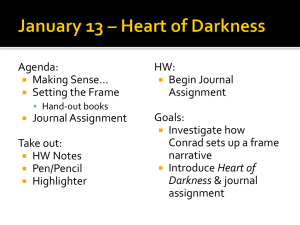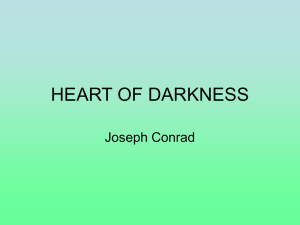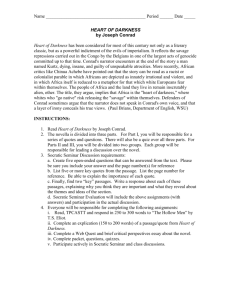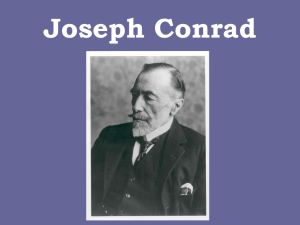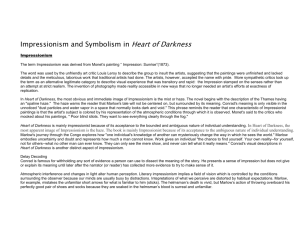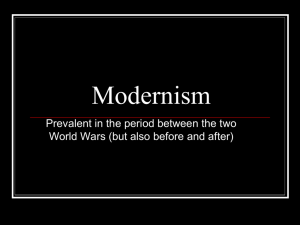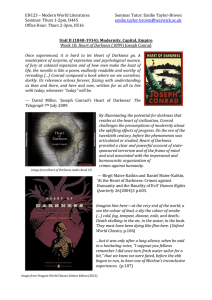Impressionism_in_Heart_of_Darkness
advertisement
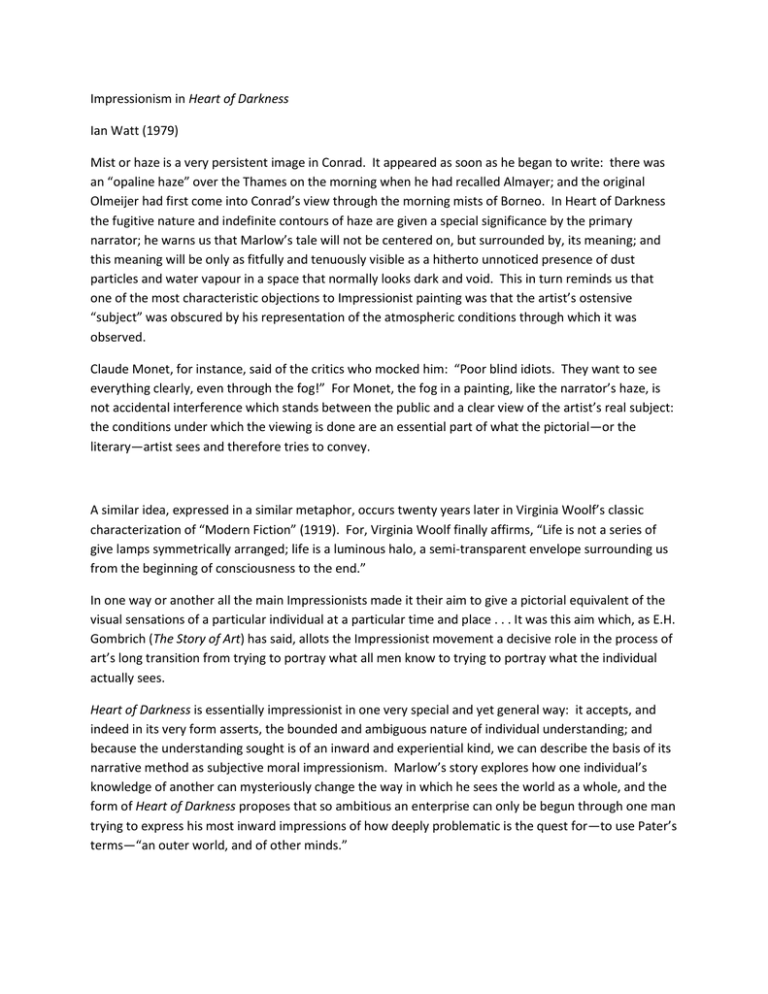
Impressionism in Heart of Darkness Ian Watt (1979) Mist or haze is a very persistent image in Conrad. It appeared as soon as he began to write: there was an “opaline haze” over the Thames on the morning when he had recalled Almayer; and the original Olmeijer had first come into Conrad’s view through the morning mists of Borneo. In Heart of Darkness the fugitive nature and indefinite contours of haze are given a special significance by the primary narrator; he warns us that Marlow’s tale will not be centered on, but surrounded by, its meaning; and this meaning will be only as fitfully and tenuously visible as a hitherto unnoticed presence of dust particles and water vapour in a space that normally looks dark and void. This in turn reminds us that one of the most characteristic objections to Impressionist painting was that the artist’s ostensive “subject” was obscured by his representation of the atmospheric conditions through which it was observed. Claude Monet, for instance, said of the critics who mocked him: “Poor blind idiots. They want to see everything clearly, even through the fog!” For Monet, the fog in a painting, like the narrator’s haze, is not accidental interference which stands between the public and a clear view of the artist’s real subject: the conditions under which the viewing is done are an essential part of what the pictorial—or the literary—artist sees and therefore tries to convey. A similar idea, expressed in a similar metaphor, occurs twenty years later in Virginia Woolf’s classic characterization of “Modern Fiction” (1919). For, Virginia Woolf finally affirms, “Life is not a series of give lamps symmetrically arranged; life is a luminous halo, a semi-transparent envelope surrounding us from the beginning of consciousness to the end.” In one way or another all the main Impressionists made it their aim to give a pictorial equivalent of the visual sensations of a particular individual at a particular time and place . . . It was this aim which, as E.H. Gombrich (The Story of Art) has said, allots the Impressionist movement a decisive role in the process of art’s long transition from trying to portray what all men know to trying to portray what the individual actually sees. Heart of Darkness is essentially impressionist in one very special and yet general way: it accepts, and indeed in its very form asserts, the bounded and ambiguous nature of individual understanding; and because the understanding sought is of an inward and experiential kind, we can describe the basis of its narrative method as subjective moral impressionism. Marlow’s story explores how one individual’s knowledge of another can mysteriously change the way in which he sees the world as a whole, and the form of Heart of Darkness proposes that so ambitious an enterprise can only be begun through one man trying to express his most inward impressions of how deeply problematic is the quest for—to use Pater’s terms—“an outer world, and of other minds.” Heart of Darkness embodies more thoroughly than any previous fiction the posture of uncertainty and doubt; one of Marlow’s functions is to represent how much a man cannot know; and he assumes that reality is essentially private and individual—work, he comments, gives you “the chance to find yourself. Your own reality—for yourself, not for others—what no other man can ever know. They can only see the mere show, and never can tell what it really means.” The other most distinctively impressionist aspect of Conrad’s narrative method concerns his approach to visual description; and this preoccupation with the problematic relation of the individual sense impressions to meaning is shown most clearly in one of the minor innovations of his narrative technique. Long before Heart of Darkness Conrad seems to have been trying to find ways of giving direct narrative expression to the way in which the consciousness elicits meaning from its perceptions. One of the devices that he hit on was to present a sense impression and to withhold naming it or explaining its meaning until later; as readers we witness every step by which the gap between the individual perception and its cause is belatedly closed within the consciousness of the protagonist. This narrative device may be termed delayed decoding, since it combines the forward temporal progression of the mind, as it receives messages from the outside world, with the much slower reflexive process of making out their meaning. . . Conrad presented the protagonist’s immediate sensations, and thus made the reader aware of the gap between impression and understanding; the delay in bridging the gap enacts the disjunction between the event and the observer’s trailing understanding of it. Conrad’s method reflects all these difficulties in translating perceptions into causal or conceptual terms. This takes us deeply into the connection between delayed decoding and impressionism: it reminds us, as Michael Levenson has said, of the precarious nature of the process of interpretation in general; and since this precariousness is particularly evident when the individual’s situation or his state of mind is abnormal, the device of delayed decoding simultaneously enacts the objective and subjective aspects of moments of crisis. The method also has the more obvious advantage of convincing us of the reality of the experience of what is being described; there is nothing suspiciously selective about the way it is narrated; while we read, we are, as in life, fully engaged in trying to decipher a meaning out of a random and pell-mell bombardment of sense impressions.
